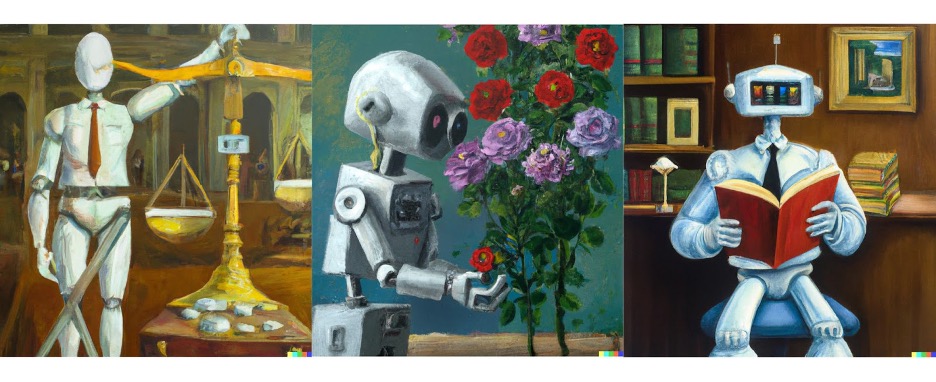
The Legal Implications of AI-Generated Art: DALL-E, MidJourney, and Intellectual Property
By Adedayo Oyetoke, Published on: June 1st 2023 5 min, 803 word Views: 1225
The rapid advancements in artificial intelligence (AI) have led to the emergence of AI-generated art, with tools like DALL-E and creative agencies like MidJourney at the forefront of this revolution. As AI-generated art becomes more prevalent, it raises important questions about intellectual property (IP) rights and the legal implications surrounding this new form of creative expression. In this blog post, we will explore the legal landscape of AI-generated art, focusing on copyright, ownership, and the challenges that lie ahead.
Copyright and AI-Generated Art
Copyright law is designed to protect the rights of creators by granting them exclusive control over their original works. However, the application of copyright law to AI-generated art is not straightforward, as it typically requires a human author to be eligible for protection. In many jurisdictions, copyright law does not recognize AI-generated works as eligible for protection, as they are not created by a human author.
Ownership of AI-Generated Art
Determining the ownership of AI-generated art can be a complex issue. In the case of DALL-E and MidJourney, the AI algorithms are developed and owned by their respective creators. However, the output generated by these algorithms may not necessarily be owned by the creators of the AI. The ownership of AI-generated art could potentially be attributed to the AI itself, the person who provided the input or prompt, or the person who owns the AI system. However, current legal frameworks do not provide clear guidance on this issue.
Challenges and Legal Debates
The legal implications of AI-generated art raise several challenges and debates:
1. Should AI-generated art be eligible for copyright protection? Some argue that granting copyright protection to AI-generated works could incentivize innovation and investment in AI technologies. Others contend that copyright protection should be reserved for human creators to encourage creativity and artistic expression.
2. If AI-generated art is eligible for copyright protection, who should be considered the author? Should it be the AI itself, the person who provided the input or prompt, or the person who owns the AI system? This question raises important philosophical and legal debates about the nature of authorship and creativity.
3. How should existing IP laws be adapted to accommodate AI-generated art? As AI-generated art becomes more prevalent, there may be a need to revise existing IP laws to provide clearer guidance on issues like copyright eligibility, authorship, and ownership.
4. What are the ethical implications of AI-generated art? AI-generated art raises important ethical questions about the role of human creativity, the potential for AI to perpetuate biases and stereotypes, and the impact of AI-generated art on the art market and the livelihoods of human artists.
Future Directions and Recommendations
As we navigate the legal implications of AI-generated art, it is essential to consider future directions and recommendations that can help create a balanced and fair legal framework. Here are some suggestions:
1. Encourage dialogue and collaboration: It is crucial for stakeholders, including lawmakers, artists, AI developers, and legal experts, to engage in open dialogue and collaboration. This will help create a shared understanding of the challenges and opportunities presented by AI-generated art and facilitate the development of appropriate legal frameworks.
2. Develop new legal frameworks: Existing IP laws may need to be revised or supplemented with new legal frameworks that specifically address AI-generated art. These frameworks should provide clear guidance on issues like copyright eligibility, authorship, and ownership while balancing the interests of human creators, AI developers, and the broader public.
3. Promote transparency and accountability: AI developers, like those behind DALL-E and MidJourney, should be encouraged to be transparent about their algorithms and the data used to train them. This can help address ethical concerns related to biases and stereotypes in AI-generated art and promote accountability in the creative process.
4. Foster education and awareness: Raising awareness about the legal implications of AI-generated art is essential for artists, AI developers, and the public. Educational initiatives can help stakeholders understand the complexities of IP law in the context of AI-generated art and empower them to make informed decisions about their creative endeavors.
5. Monitor and adapt to technological advancements: As AI technologies continue to evolve, it is important for legal frameworks to adapt accordingly. Regular monitoring and assessment of the impact of AI-generated art on the creative industries and IP law will help ensure that legal frameworks remain relevant and effective in the face of rapid technological change.
In conclusion, the legal implications of AI-generated art, as exemplified by DALL-E and MidJourney, present a unique set of challenges and opportunities. By fostering dialogue, collaboration, and innovation, we can develop legal frameworks that support the growth of AI-generated art while protecting the rights and interests of human creators, AI developers, and the broader public. The future of AI-generated art is full of potential, and with the right legal frameworks in place, we can ensure that this potential is realized in a responsible and equitable manner.
